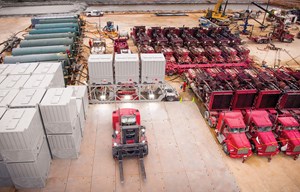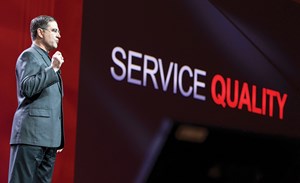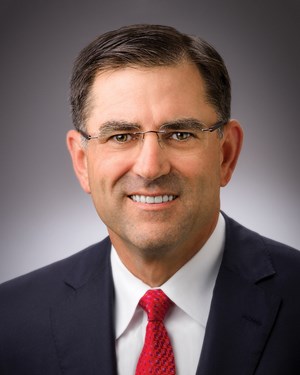Jeff Miller shares his vision for Halliburton’s future
World Oil: What are your near-term priorities for Halliburton during your first 12 months as CEO?
Jeff Miller: My primary focus is to collaborate on engineering solutions, and maximize asset value for our customers. This strategy is consistent with our DNA, it’s our culture, and we collectively have put words around what is most important to our customers. Collaboration is a priority—you’ll hear that said by many companies—but I think we are doing it. We’ve got some clear metrics around what it looks like when we’re doing it. Obviously, we want to deliver industry-leading returns, which also defines some things. And, I’m really excited about that—we’ve been using those words for about a year now. It gets great traction with our customers and our own people, and it delivers real results. We don’t want to be anybody else, we want to be Halliburton.
WO: Are there specific areas of the world that you are focusing on?
Miller: I’ll quote (Executive Chairman) Dave (Lesar) to say, I’ll never apologize for a leading share in the largest oil service market in the world, which is North America. And because of that, what gets left out of the conversation is how successful we are around the world. We are not a North America-only company by any means. We have very solid business in every region worldwide; there aren’t any countries that we don’t work in, unless there are sanctions in place for some reason. I think the Middle East, Eurasia and North America are very resilient markets. Absolutely, we want to grow our business in all three places.
WO: About a year ago, Saudi Arabia said that it wanted more local content and actually more manufacturing of oilfield products within the country. Is that still the plan?
Miller: That’s still the plan, and we will support those efforts. We do have manufacturing in many countries around the world, including a large business in Singapore. And our technology is spread equally around the world. We have a very important R&D facility in Saudi Arabia—we do novel research there. But we also have key research centers in Brazil, India and Singapore, and there are some smaller ones in other places.
WO: With the U.S. rig count increasing more than 50% during the past year, especially in the shale plays, do you see pricing for pressure pumping and other services increasing?
Miller: The entire North American service industry has operated at a loss for the last couple of years. Clearly, there has to be pricing momentum that moves up, to sustain the service industry that’s here. Our customers are investing to meet production targets today; that certainly helps. I would describe it as urgent. When customers are urgent, that helps move pricing up. We are reactivating equipment into a market that has leading-edge pricing, but that’s also indicative of the demand that we’re seeing. When I see that happening, it makes me really comfortable with what our guys are doing, in delivering service quality. But all of the value propositions in any industry are stressed at the bottom. At the very bottom, it’s hard to differentiate on anything other than price.
WO: As land rig day rates go up, how do you equate 900 rigs today, to what the equivalent figure was in 2010 or 2012?
Miller: If you look at the efficiency of the rigs, from a completion standpoint, 900 is the new 2,000. I say that, because rig efficiency, and the ability to drill faster and for more footage, are coupled with about a 3x increase in sand volumes since Q3 of 2014. All of that conspires to drive a level of activity that looks and feels like what we had at the peak.
Stage counts have gone up, cluster spacing has shrunk, and that means more sand through the pump, more sand downhole, more sand on the rail, more sand to be mined. We work with all of the sand suppliers, in one way or another. I go back to my value statement—if it helps us collaborate, if it helps us engineer a solution that will ultimately lower cost per boe, then those are things that we invest in, if they are unique to us.
WO: As you bring pressure pumping units back into service, is the ability to bring people back to run the equipment an issue?
Miller: We are reactivating equipment, and I can’t say enough good things about our team in Duncan, Okla. That facility has been in the Halliburton family since the beginning—an incredible resource in terms of our speed to market. In that reactivation, we hired people in the second week of December, and they were reactivating equipment, starting Jan. 1. It was a two-week startup, to a fairly big operation, and kudos to that team and the flexibility that it affords us.
In hiring field personnel, we were fortunate to hire a number of our former employees back. There’s absolutely nothing worse that an executive has to do than let people go; that was awful. And good people, a lot of good people. So, we’ve worked as hard as we could to start by bringing that group back—we’ve had a pretty good success rate, about 50%. And when we get beyond that, the apparatus to hire a lot of people is there. We hired 21,000 people in 2014. If you think about putting 21,000 new names on the payroll, imagine the number of resumes we screened and the fit-for-duty tests that were performed.
WO: Any problems getting sand, with the volumes that you’re pumping these days, while prices have gone up?
Miller: Well, we see some tightness, and prices have gone up. But I also think that they’ll come back down—at what pace, I don’t know. But we think there’s 45 MMt of new supply waiting to come on during the coming quarters, and that will create downward pressure on sand and make it available. To a certain degree, tightness starts to open the conversation around what is a better design, potentially, for a more efficient frac. Because, if you’re indifferent about the price of sand, and it’s infinitely available, then you don’t have a discussion around “how can I be more effective and pump less sand, and ultimately less sand means less wear on the equipment, it means less cost to our clients, and it’s ultimately better for North America, by bringing down cost.”
We have not seen that in great quantities, but we have had some successful discussions with clients, when we reach situations where a particular mesh size is not available, to go back and redesign jobs—say there’s a much more cost-effective way to do that with available sand. I believe over time, redesigning completions will be more relevant. That’s why a lot of the R&D dollars that we spend are around how to make a better well.

WO: The IPs on most of the wells in the Permian averaged 98 bopd in 2010, and now it’s closer to 700 bopd—the industry has made a lot of progress, wouldn’t you say?
Miller: Yes, but I think North America is not infinite. There’s a lot of decline happening—if you go beyond the Middle East, Eurasia and North America, look at just the capital starvation that’s happened in our industry. We see that in our international business every day. We’re in the third year of meaningful reductions in capital spent, and that will have an effect. Physics always wins at this game, and physics means production declines. We’re seeing some tell-tale signs where it’s starting to have an effect. Once it starts to decline, it’s a lot harder to turn that around. I think the North American inventory is the most visible, it’s the best-measured inventory, but it’s not the only inventory. To study and measure non-U.S. inventory, you can just look at reductions in rig counts. You start to see, that even if we talk about a modest recovery, and I emphasize modest in the second half of ’17, it pales in comparison to what was being done before,
internationally.
WO: The global offshore market remains depressed. Not enough new projects are replacing the ones being completed. When do you see offshore activity improving, especially in the Gulf of Mexico?
Miller: It feels like it could be 2020—it’s out there. It’s not months, and we’ve been more pessimistic than others in the services industry. It’s playing out around the international and deepwater space. I think over time, deep water will be as relevant as it once was. But there is a cost re-set that’s harder to do in deep water; you get fewer at-bats. On land, it’s a lot easier to test, try, iterate, do better. Exploration wells, by definition, are exploration. It’s hard—you don’t drill 50 of them in a short period of time, you drill one. But there are places where the denominator is so big that it brings interest. Deep water is very competitive, if the discovery is of adequate size. Brazil fits those requirements; hence the interest there.
Parts of the Gulf, though tougher, will have those same attributes, but not everywhere. As long as demand grows 1% per year, and let’s just use a rough 3% estimate of decline, that creates a 20-MMbpd gap over five years. We’re not going to produce another 20 MMbpd in North America over five years, so deep water has an important role. There has been progress in reducing the deepwater cost per boe.
Deep water suffers from two things: the exploration and infrastructure cost that goes with it, and then there’s also a duration issue in many markets, and that’s seven to 10 years to bring it on. Now, tiebacks are a lot quicker, and we see more of these step-outs and tie-backs that better utilize the capital that’s there. But the Gulf of Mexico’s fantastic. It reinvents
itself like the Permian. It seems like every decade, there’s a new strategy in the Gulf that works. I never count it out.
WO: Can you speak more to the technical aspects?
Miller: I think of the collaborative engineered solutions, to maximize asset value for our customers, as our operating system. Inside that are some important apps that bolt on. Unconventionals, mature fields and deep water are still incredibly important apps. A lot of today’s technology was born out of deepwater demands; it gets adapted and made cheaper.
So, we love where we are with our deepwater prospects. We won some important contracts in the Gulf of Mexico, and we have the region’s leading market share. The big contract wins demonstrate that Halliburton is competitive in all the services that we’re in, including open-hole, deepwater wireline. We’ve logged several 37,000-ft-plus wells this year, open-hole. You don’t historically think of Halliburton doing that, but we’ve got a solid open-hole deepwater logging business in the Gulf of Mexico. That’s new for us in the last five years.
WO: For years, service companies have presented packages to operators, where they do everything from exploration to managing production. Have those packages been successful?
Miller: In some ways, I’ve seen that movie before, because we had KBR. I think two things about that. I like the businesses that we’re in, and they have the best full-cycle returns. The degree to which it’s required, we’ve got good relationships with other companies, where I think we can continue to do those things that create value for us and work with others. But to go acquire things that demonstrate lower structural returns in the businesses that we’re in is not a good use of our shareholders’ money. The last point that I would make is that if it’s in fact a shift to EPC, that’s a very different risk profile than what we’re in today. If subsea kit becomes EPC, it’s important to recognize that that’s a change in the historical risk profile of that business.
WO: Does Halliburton have its own technical R&D priorities?
Miller: Technology is a tool to make returns—that gets lost, sometimes, in the talk about it. It has to meet a customer requirement—gain efficiencies or make more barrels. And it has to provide a return to Halliburton. So, there are a lot of things that we could work on, but would not ultimately accrue to us. In general, there are some great things that we’re doing around efficiency and better reservoir insight around drilling.
I’m excited about our digital strategy, which originally came from Landmark, but which is more broadly defined as open-access. We’ve opened our Landmark platform to the source code, to developers through the Open Earth community, which allows customers to innovate in that environment or leverage what’s already there. We made some core decisions around cloud computing several years ago that will pay off over time. I do believe that our clients are going to demand open-access architecture. And, then, automation of fields, we’re doing that in different parts of the world. So, I think that’s a big area that will evolve and change the business.
WO: Some industry analysts feel that oil prices will remain in the $40-to-$50 range for the remainder of 2017. Do you agree?
Miller: I think we’re going to be in a range-bound environment for a while. When I say range-bound, I hope it’s $50 to $60, but it could be $40 to $50, considering where we are lately. But I think we can all make a return in that environment, if we’re effective, if we manage costs, if we’re working on continuous improvement steps all the time, taking costs out. We took a billion dollars out of our business over the last year. So, I think that’s a range where unconventionals work, but a lot of other things would be stressed. It is a matter of recalibrating around what that means.
WO: How does the global supply-and-demand picture look to you?

Miller: Back to my comments earlier, I think we’re underestimating the risk in the system today, with just 1.5 MMbpd of spare capacity sloshing around—that’s the least it’s ever been. I think that declines in Venezuela, Mexico, Angola, Indonesia, Malaysia and China mean something—we get very myopic around the Middle East, Eurasia and North America. Now, granted, all three are very relevant. But the rest still matter, too. That’s about a third of what we need to do every day. In those markets, the recovery will be mature fields first, to the degree that they come back on, and then deep water.
WO: Where would you like to see Halliburton four or five years from now, in market coverage?
Miller: We want to grow all the time, although I don’t know what that share number would be. Our guys tend to outperform the targets that we give them. I have great gratitude for how the Halliburton men and women execute. I’ve always said, that we want to have a growing and bigger lift business, and a bigger and growing chemicals business, which would help address the production part of the market.
So, when I think about Halliburton four or five years from now, I’d like to see that part of our business growing and thriving, along with the rest of it. Yeah, we’re maintaining our footprint around the world, internationally, and would expect to grow and outgrow those markets, whatever they will give us. In North America, we have a solid share. Historically, we would see our share decline, as activity picked up. But we worked really hard to gain a lot of share in the downturn, and we want to at least settle out at a higher-than-historical market share, when activity evens out.
WO: What has it been like for you to make the adjustment to being CEO?
Miller: I feel like I’ve been 20 years in training for this job. I’ve served in a variety of roles for 20 years, and I’ve had a chance to work in many parts of the business. I’ve spent the last five years working directly with Dave (Lesar), developed strategies, developed a lot of leadership teams that are here today. I’m still working on a lot of the same things. And I think that the things that I worked on before are the same right things to work on now. ![]()
- Coiled tubing drilling’s role in the energy transition (March 2024)
- Advancing offshore decarbonization through electrification of FPSOs (March 2024)
- The reserves replacement dilemma: Can intelligent digital technologies fill the supply gap? (March 2024)
- Oil and gas in the Capitals (February 2024)
- What's new in production (February 2024)
- Subsea technology- Corrosion monitoring: From failure to success (February 2024)



